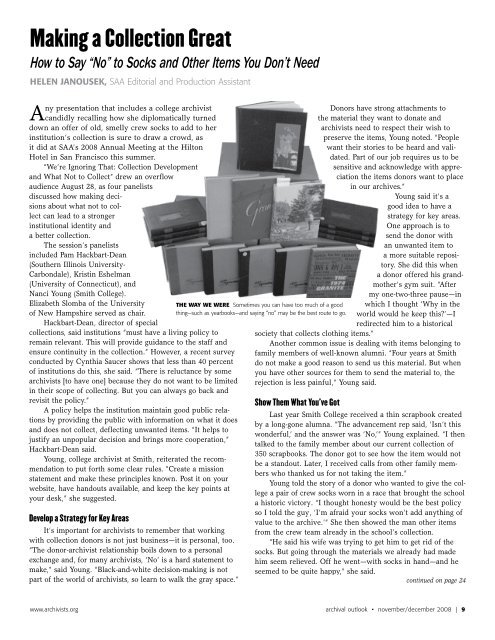Tally Ho! - Society of American Archivists
Tally Ho! - Society of American Archivists
Tally Ho! - Society of American Archivists
Create successful ePaper yourself
Turn your PDF publications into a flip-book with our unique Google optimized e-Paper software.
Making a Collection Great<br />
<strong>Ho</strong>w to Say “No” to Socks and Other Items You Don’t Need<br />
HELEN JANOuSEk, SAA Editorial and Production Assistant<br />
Any presentation that includes a college archivist<br />
candidly recalling how she diplomatically turned<br />
down an <strong>of</strong>fer <strong>of</strong> old, smelly crew socks to add to her<br />
institution’s collection is sure to draw a crowd, as<br />
it did at SAA’s 2008 Annual Meeting at the Hilton<br />
<strong>Ho</strong>tel in San Francisco this summer.<br />
“We’re Ignoring That: Collection Development<br />
and What Not to Collect” drew an overflow<br />
audience August 28, as four panelists<br />
discussed how making decisions<br />
about what not to collect<br />
can lead to a stronger<br />
institutional identity and<br />
a better collection.<br />
The session’s panelists<br />
included Pam Hackbart-Dean<br />
(Southern Illinois University-<br />
Carbondale), Kristin Eshelman<br />
(University <strong>of</strong> Connecticut), and<br />
Nanci Young (Smith College).<br />
Elizabeth Slomba <strong>of</strong> the University<br />
<strong>of</strong> New Hampshire served as chair.<br />
Hackbart-Dean, director <strong>of</strong> special<br />
collections, said institutions “must have a living policy to<br />
remain relevant. This will provide guidance to the staff and<br />
ensure continuity in the collection.” <strong>Ho</strong>wever, a recent survey<br />
conducted by Cynthia Saucer shows that less than 40 percent<br />
<strong>of</strong> institutions do this, she said. “There is reluctance by some<br />
archivists [to have one] because they do not want to be limited<br />
in their scope <strong>of</strong> collecting. But you can always go back and<br />
revisit the policy.”<br />
A policy helps the institution maintain good public relations<br />
by providing the public with information on what it does<br />
and does not collect, deflecting unwanted items. “It helps to<br />
justify an unpopular decision and brings more cooperation,”<br />
Hackbart-Dean said.<br />
Young, college archivist at Smith, reiterated the recommendation<br />
to put forth some clear rules. “Create a mission<br />
statement and make these principles known. Post it on your<br />
website, have handouts available, and keep the key points at<br />
your desk,” she suggested.<br />
Develop a Strategy for Key Areas<br />
It’s important for archivists to remember that working<br />
with collection donors is not just business—it is personal, too.<br />
“The donor-archivist relationship boils down to a personal<br />
exchange and, for many archivists, ‘No’ is a hard statement to<br />
make,” said Young. “Black-and-white decision-making is not<br />
part <strong>of</strong> the world <strong>of</strong> archivists, so learn to walk the gray space.”<br />
Donors have strong attachments to<br />
the material they want to donate and<br />
archivists need to respect their wish to<br />
preserve the items, Young noted. “People<br />
want their stories to be heard and validated.<br />
Part <strong>of</strong> our job requires us to be<br />
sensitive and acknowledge with appreciation<br />
the items donors want to place<br />
in our archives.”<br />
Young said it’s a<br />
good idea to have a<br />
strategy for key areas.<br />
One approach is to<br />
send the donor with<br />
an unwanted item to<br />
a more suitable repository.<br />
She did this when<br />
a donor <strong>of</strong>fered his grandmother’s<br />
gym suit. “After<br />
my one-two-three pause—in<br />
which I thought ‘Why in the<br />
world would he keep this?’—I<br />
redirected him to a historical<br />
society that collects clothing items.”<br />
Another common issue is dealing with items belonging to<br />
family members <strong>of</strong> well-known alumni. “Four years at Smith<br />
do not make a good reason to send us this material. But when<br />
you have other sources for them to send the material to, the<br />
rejection is less painful,” Young said.<br />
the WAy We Were Sometimes you can have too much <strong>of</strong> a good<br />
thing—such as yearbooks—and saying “no” may be the best route to go.<br />
Show Them What You’ve Got<br />
Last year Smith College received a thin scrapbook created<br />
by a long-gone alumna. “The advancement rep said, ‘Isn’t this<br />
wonderful,’ and the answer was ‘No,’” Young explained. “I then<br />
talked to the family member about our current collection <strong>of</strong><br />
350 scrapbooks. The donor got to see how the item would not<br />
be a standout. Later, I received calls from other family members<br />
who thanked us for not taking the item.”<br />
Young told the story <strong>of</strong> a donor who wanted to give the college<br />
a pair <strong>of</strong> crew socks worn in a race that brought the school<br />
a historic victory. “I thought honesty would be the best policy<br />
so I told the guy, ‘I’m afraid your socks won’t add anything <strong>of</strong><br />
value to the archive.’“ She then showed the man other items<br />
from the crew team already in the school’s collection.<br />
“He said his wife was trying to get him to get rid <strong>of</strong> the<br />
socks. But going through the materials we already had made<br />
him seem relieved. Off he went—with socks in hand—and he<br />
seemed to be quite happy,” she said.<br />
continued on page 24<br />
www.archivists.org archival outlook • november/december 2008 | 9


